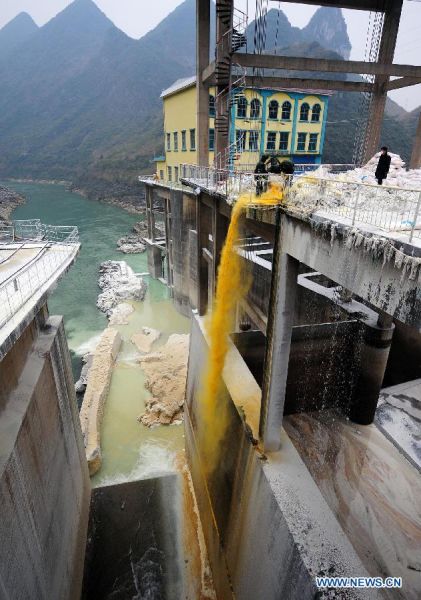Cadmium pollution contained in S. China river
 0 Comment(s)
0 Comment(s) Print
Print E-mail
China.org.cn, January 29, 2012
E-mail
China.org.cn, January 29, 2012
Cadmium pollution in a south China river was contained Sunday after the local environment watchdog confirmed no new leaks were found at the upstream source of the contamination.
|
|
|
Firefighters work to put in chemicals made from dissolved aluminum chloride to neutralize the polluted Longjiang River in Hechi City, south China's Guangxi Zhuang Autonomous Region, Jan. 26, 2012.?[Xinhua/Huang Xiaobang] |
Cadmium pollution in a south China river was contained Sunday after the local environment watchdog confirmed no new leaks were found at the upstream source of the contamination.
Cadmium concentration levels in Lalang Reservoir of the Longjiang River in the Guangxi Zhuang Autonomous Region were normal Sunday, indicating the source of the pollution had been cut off, the environment protection bureau of Hechi city said in a press release.
The contamination was first detected on Jan. 15 and was traced to a plant belonging to Guangxi Jinhe Mining Co., Ltd.
In Hechi, the pollution killed many fish and prompted panic buying of bottled water over the past week.
The city's vice mayor Li Wengang said local authorities put hundreds of tonnes of neutralizers, made from dissolved aluminum chloride, into the Longjiang River to dissolve the contamination.
"It's good news the source of pollution has been cut at the source," said Gan Jinglin, environment chief in the downstream city of Liuzhou.
Yet water security remains a critical problem for Liuzhou, which has 1.5 million permanent residents in the city proper.
Over the past week, the pollutants were flowing downstream to Liujiang River. As of Sunday morning, the front of the pollution belt was close to the city's major drinking water source.
Longjiang is a tributary upstream of Liujiang River.
The cadmium concentration at the Nuomitan hydropower station, located 56 km away from the Hexi water plant in Liuzhou, was eight times higher than the official limit of 0.005 milligrams per liter as of noon on Sunday.
Water located within a 16-km radius from the Hexi water plant is considered vital for water supply safety. The Sunday morning tests showed that the cadmium concentration on a section of river 16 km from the plant was 0.0041 milligrams per liter, just below the official limit, Gan said.
The rising cadmium concentration, however, means that the pollutants are approaching, and it is still unknown when the concentration peak will occur and how high it will be," Gan said. "We are keeping a close eye on the river's water quality."
Though Gan said the water plant was unlikely to halt production in the coming four days, the pollution has seriously affected the lives of fishermen along the Liujiang River.
The family of Xie Shuisheng from Fengshan township, Liucheng county, lives on a boat.
"We have to drive our boat to the Rongjiang River to fetch drinking water, as we were told a couple of days ago that the Longjiang River was polluted and the water is undrinkable," Xie said. "We dare not to fetch water from the river before the threat is eased."
All the fishermen worried the pollution might kill the river's fish and cut off their major source of income.
Cadmium is a carcinogenic chemical mostly used in industrial effluents.
All seven of the heavy metal production plants located upstream of the river have suspended operations in order to curb potential sources of new pollution.
Jinhe Mining Co., Ltd is one of the most suspected sources of the pollutant, as its dumping site is not up to national standard, according to Wu Haique, environment protection chief in Hechi city.
However, further investigations into other plants must be conducted as more proof is needed to ascertain the sources of the pollution, Wu said.
"A team of specialists are in Hechi to provide technical assistance, including water conservation and environmental protection experts, as well as geologists -- as the karst caves along the river make it harder to locate the pollution source."






